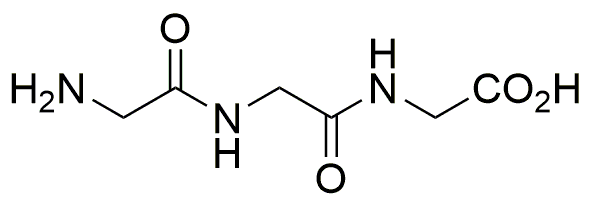Gly-Gly-Gly-OH is widely utilized in research focused on:
- Peptide Synthesis: This compound serves as a building block in the synthesis of peptides, which are essential in drug development and biochemical research.
- Biotechnology: It is used in the formulation of biopharmaceuticals, enhancing the stability and efficacy of protein-based drugs.
- Cosmetic Industry: Gly-Gly-Gly-OH is incorporated into skincare products for its moisturizing properties, helping to improve skin hydration and texture.
- Food Industry: It acts as a flavor enhancer and preservative in certain food products, contributing to improved taste and shelf-life.
- Research Applications: This compound is utilized in various laboratory studies, including those focused on cellular processes and metabolic pathways, providing insights into biological functions.
General Information
Properties
Safety and Regulations
Applications
Gly-Gly-Gly-OH is widely utilized in research focused on:
- Peptide Synthesis: This compound serves as a building block in the synthesis of peptides, which are essential in drug development and biochemical research.
- Biotechnology: It is used in the formulation of biopharmaceuticals, enhancing the stability and efficacy of protein-based drugs.
- Cosmetic Industry: Gly-Gly-Gly-OH is incorporated into skincare products for its moisturizing properties, helping to improve skin hydration and texture.
- Food Industry: It acts as a flavor enhancer and preservative in certain food products, contributing to improved taste and shelf-life.
- Research Applications: This compound is utilized in various laboratory studies, including those focused on cellular processes and metabolic pathways, providing insights into biological functions.
Documents
Safety Data Sheets (SDS)
The SDS provides comprehensive safety information on handling, storage, and disposal of the product.
Product Specification (PS)
The PS provides a comprehensive breakdown of the product’s properties, including chemical composition, physical state, purity, and storage requirements. It also details acceptable quality ranges and the product's intended applications.
Certificates of Analysis (COA)
Search for Certificates of Analysis (COA) by entering the products Lot Number. Lot and Batch Numbers can be found on a product’s label following the words ‘Lot’ or ‘Batch’.
*Catalog Number
*Lot Number
Certificates Of Origin (COO)
This COO confirms the country where the product was manufactured, and also details the materials and components used in it and whether it is derived from natural, synthetic, or other specific sources. This certificate may be required for customs, trade, and regulatory compliance.
*Catalog Number
*Lot Number
Safety Data Sheets (SDS)
The SDS provides comprehensive safety information on handling, storage, and disposal of the product.
DownloadProduct Specification (PS)
The PS provides a comprehensive breakdown of the product’s properties, including chemical composition, physical state, purity, and storage requirements. It also details acceptable quality ranges and the product's intended applications.
DownloadCertificates of Analysis (COA)
Search for Certificates of Analysis (COA) by entering the products Lot Number. Lot and Batch Numbers can be found on a product’s label following the words ‘Lot’ or ‘Batch’.
*Catalog Number
*Lot Number
Certificates Of Origin (COO)
This COO confirms the country where the product was manufactured, and also details the materials and components used in it and whether it is derived from natural, synthetic, or other specific sources. This certificate may be required for customs, trade, and regulatory compliance.

